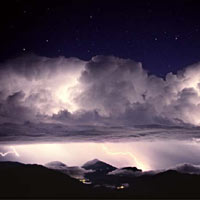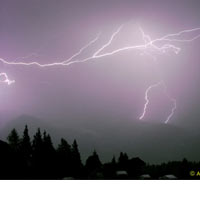


No one is sure how lightning gets started, but one theory is that incoming cosmic rays from outer space serve as the trigger. Here, stars shine above a thunderstorm in the Alps. 
Lightning within clouds is far more common than lightning that strikes the ground. Above, a storm photographed near Emberger Alm, Austria, in August 2003. |
Most of the four million lightning flashes that occur on our planet each day originate from inside thunderclouds, often just a few miles above our heads, and yet despite decades of research we still don't understand what is happening inside clouds to start the common lightning bolt. In order to get a conventional spark, the kind that a spark plug makes, the electric field needs to surpass the conventional breakdown field, the point at which air loses its insulating properties and becomes capable of conducting electricity. For air, this is about 70,000 volts per inch at sea level. A car accomplishes this by supplying a high voltage—say 20,000 volts—across the narrow gap of the spark plug. Thunderstorms can also generate big voltages. They do this when ice and water particles carried by updrafts collide with soft hail carried downward by gravity. The voltages produced by the resulting charge separation are impressive, sometimes exceeding 100,000,000 volts. But unlike a spark plug, in a thunderstorm the voltage gets applied across a mile or more, resulting in an electric field that appears to be too small to start a spark. Indeed, decades of balloon, aircraft, and rocket measurements have rarely found electric fields even one tenth the minimum value needed by a spark plug to make a spark in air. Of course, lightning does occur inside thunderclouds, so clearly we must be missing something about how lightning gets started. Several ideas have been suggested, including colliding raindrops, localized regions of concentrated charge, and avalanches of high-energy electrons initiated by cosmic rays from outer space. At least for now, however, no one knows what the right answer is. Following the leaderWe do know that once lightning is initiated, somehow a hot channel called a leader quickly forms. As I noted earlier, air is normally an insulator, so in order for the lightning discharge to propagate from its point of origin to other locations such as the ground, the air along the path must be broken down, allowing electrical charges to move freely. The leader accomplishes this by concentrating charge at its tip and thereby producing a large electric field, just like a spark plug. This causes a discharge in front of the leader, allowing it to move forward. To keep the process going, however, new charge must be supplied continuously to the leader tip; it is the electrical current that moves this charge along the hot leader channel. The leader's high temperature keeps the air in the channel conductive long enough for the current to flow across many miles of air. Interestingly, the initial leader does not travel in a smooth, continuous manner but rather in a series of short jumps called steps. This is why the initial leader is called the "stepped leader." During a step, the leader shoots forward about 150 feet, often in a new direction. It takes on average about seven-one thousandths of a second for the stepped leader to travel each mile in this stop-and-go fashion. Moreover, sometimes during the stepping process, the leaders branch into two channels. It is thus the stepping of the initial leader that gives lightning its characteristic jagged, forked appearance. Despite lightning's familiarity, however, no one knows why lightning leaders behave this way. Ground strokesSometimes the currents that flow through the leader as it propagates are large enough to make the leader appear very bright. Most of the lightning we see does not actually connect with the ground and instead is caused by currents flowing along channels linking various parts of the same cloud, the surrounding air, or more rarely different clouds. If the stepped leader does connect with the ground, however, a short circuit between the cloud and the earth occurs and large currents will flow, starting at the ground and propagating upward. These currents will partially neutralize the voltage difference the thunderstorm generated. This process is called the return stroke. Electric currents in the return stroke can be very large, measured in tens of thousands of amperes. The huge currents rapidly heat the air to roughly 50,000°F—about four times hotter than the surface of the sun.
It is this hot channel produced by the return stroke that we see during
cloud-to-ground lightning, and the rapid expansion and subsequent contraction
of the hot channel begets the thunder we hear. Frequently, after the return
stroke, the thunderstorm will send down another leader, this time called a dart
leader, that quickly recharges the channel and leads to another return stroke.
The fast succession of leaders and bright return strokes is what causes a
lightning flash to flicker.
|
||||||||||

Joe Dwyer is an Associate Professor of Physics and Space Sciences at the Florida Institute of Technology. To see a fuller bio—and ask him a question about lightning—go to Ask the Expert. |
|||||||||||
|
© | Created October 2005 |
|||||||||||